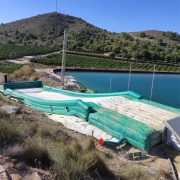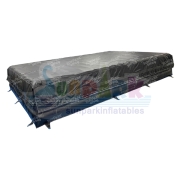Introduction — why the best foam pit airbag matters
If you operate a gym, trampoline park, or an action-sports training center, choosing the best foam pit airbag is one of the most impactful investments you can make. Modern foam pit airbags combine engineered impact attenuation, easy sanitation, rapid reset, and lower lifetime maintenance compared with loose foam pits. This guide explains what to look for, compares top functional criteria, gives sizing and operations advice, includes a buyer’s checklist, and links directly to relevant SunparkAirbag product pages so you can get quotes and technical sheets quickly.
Throughout this article I’ll use your tag keywords as anchor text to relevant pages:
(Other helpful product pages and resources are linked naturally in the body to improve navigation and help your editorial team.)
1. What is a foam pit airbag and how does it differ from a traditional foam pit?

A foam pit airbag is an inflatable landing system that either replaces or overlays loose foam cubes. Instead of guests landing into a pile of foam blocks that shift and compress, the airbag uses engineered chambers, pillars or dual zones to absorb impact energy in a predictable way. Key differences:
Hygiene: airbag shells are wipeable and non-porous; foam cubes trap sweat, dust and odor.
Consistency: airbags provide repeatable attenuation; foam cubes compress and change feel over time.
Throughput: airbags allow faster exit and reset, improving class throughput and event capacity.
Maintenance: fewer consumables and simpler repairs (patchable shell) versus ongoing cube replacement.
If you want to evaluate product specs, start with Sunpark’s best foam pit airbag product page: https://www.sunparkairbag.com/product/foam-pit-airbag/.
2. Why gyms and trampoline parks are switching to foam pit airbags
Facility managers switch for operational and safety reasons. The most common drivers are:
Faster cleaning and better hygiene. Indoor parks face intense scrutiny for cleanliness; an airbag shell that wipes down in minutes is a huge benefit. (See Sunpark’s foam-pit solutions.)
Higher throughput and revenue per hour. With faster egress and lower staff touch, sessions can handle more kids and classes, increasing revenue and reducing queue times.
Reliable athlete progression. Coaches prefer consistent landings that give athletes predictable feedback and quicker skill transfer.
Lower long-term costs. Although CAPEX may be comparable, total cost of ownership tends to favor airbags in medium-to-high usage facilities because you avoid recurring foam cube replacements and disposal.
For indoor park-specific solutions, check the trampoline park equipment page for compatible accessories: https://www.sunparkairbag.com/product/trampoline-airbag/.
3. Core features to evaluate in the best foam pit airbag
When comparing models, focus on these technical and operational attributes:
3.1 Impact attenuation architecture
3.2 Venting and tunability
3.3 Topsheet material & abrasion resistance
3.4 Anchor points & stability
3.5 Repairability & spare parts
3.6 Hygiene features
Sunpark’s product pages list many of these specs—start at the Foam Pit Airbag page to request datasheets: https://www.sunparkairbag.com/product/foam-pit-airbag/.
4. Comparison table — top decision criteria

| Criterion | Best Foam Pit Airbag (engineered) | Traditional Foam Pit (blocks) |
|---|
| Hygiene / cleanability | High — smooth shell, wipeable | Low — blocks trap sweat/dust |
| Consistency of landings | High — engineered attenuation | Variable — blocks shift |
| Throughput | High — fast egress, quick reset | Low — manual rearrangement |
| Maintenance effort | Low-medium — blower & seam checks | High — cube replacement, washing |
| Long-term cost (TCO) | Favorable for high usage | Favorable for low-usage short-term |
| Environmental impact | Lower (less waste) | Higher (foam disposal) |
| Multi-user simultaneous impacts | Good (pillar designs handle multiple) | Risk of bottom-out if cubes shift |
| Initial CAPEX | Moderate to high | Moderate |
| Customization | High — branding, size, vents | Low |
Use this table when presenting options to stakeholders and when building your ROI model.
5. Sizing guidance — choose footprint & cushion depth
Selecting the right footprint depends on the intended activities:
Toddler / beginner area: footprint 4–6 m × 3–4 m; cushion depth 0.8–1.2 m.
Gymnastics training: footprint 8–12 m × 6–8 m; cushion depth 1.2–1.8 m.
Trampoline pit / stunt training (high throughput): footprint 10–14 m × 8–10 m; cushion depth 1.5–2.2 m.
Always measure run-in speeds, expected fall heights, and target user weight distribution before finalizing size. Sunpark’s sizing guidance and product drawings (available via the Products hub) will help finalize engineering requirements.
6. Operational best practices for gyms and trampoline parks

6.1 Site preparation
Level substrate, protective groundsheet and no-sharp-object policy.
Adequate blowers and power redundancy; confirm blower specs and noise levels.
6.2 Staff training & procedures
Standard Operating Procedure (SOP): vent settings per session type, max weights, allowed footwear.
Briefing script: consistent safety brief for every user with posture and exit instructions.
Daily log: blower hours, vent positions, cleaning actions, incidents.
6.3 Hygiene routine
Wipe-down shell at start/end of day and between busy sessions.
Use removable top covers for camps and parties to reduce direct shell contact.
Maintain a cleaning log—this helps with inspections and insurer requirements.
6.4 Throughput tactics
Stagger entries, use a “prepare” line and a “jump” line to maintain flow.
Use signage and short instructional videos to reduce staff time spent on individual briefings.
7. Safety standards, testing and authoritative guidance
When specifying equipment or preparing SOPs, reference recognized guidance:
ASTM International — standards and practices for recreational and inflatable devices. (https://www.astm.org/)
U.S. Consumer Product Safety Commission (CPSC) — general guidance on trampoline and playground safety. (https://www.cpsc.gov/)
RoSPA (Royal Society for the Prevention of Accidents) — safe play and leisure guidance for UK/EU projects. (https://www.rospa.com/)
Ask your supplier for attenuation test reports and third-party certificates. These documents are important for insurer sign-off and local permitting.
8. The economy of ownership — CAPEX, OPEX and ROI
8.1 Capital expenses (CAPEX)
Airbag, blower(s), anchors, platform or surround, signage and site prep.
8.2 Operating expenses (OPEX)
Electricity (blowers), cleaning supplies & staff time, occasional patches/repairs, parts replacement.
8.3 Revenue uplift possibilities
Increased session throughput (more tickets per hour).
New programs (camps, skills classes) that charge premiums for hygienic, high-quality training.
Event rentals — offering an airbag plate for birthday parties or corporate events often commands higher margins.
8.4 5-year TCO modelling
Build a model that includes foam cube replacement costs (for comparison), disposal fees, cleaning labor and airbag maintenance costs. In many medium-to-high use scenarios, an airbag delivers lower lifetime costs and higher revenue opportunity.
For quotes and actual product pricing, use SunparkAirbag’s Products hub to request detailed proposals: https://www.sunparkairbag.com/products/.
9. Case examples — how facilities use foam pit airbags
Case A — Indoor trampoline park (mid-size)
Problem: foam blocks created long cleaning windows and reduced throughput during camps.
Solution: retrofitted a foam pit airbag in the training area and ran kids’ camps there.
Result: cleaning time dropped by 60%, camp capacity increased by 30%, and customer NPS (satisfaction) improved due to perception of cleanliness.
Case B — Gymnastics academy
Problem: foam pit inconsistency affected skill transfer.
Solution: installed a larger gym airbag with tunable vents and a removable top sheet.
Result: athletes progressed faster with fewer teachers needed per class; the academy added more classes without hiring extra coaches.
Case C — Multi-sport training center
Problem: needed an adaptable solution for BMX-to-snow camps and trampoline-to-ski progression.
Solution: used a foam-pit-airbag hybrid plus a trampoline airbag for air awareness.
Result: seamless cross-discipline training and more off-season revenue streams.
You can explore hybrid and product options on the Sunpark product pages: foam pit airbag https://www.sunparkairbag.com/product/foam-pit-airbag/ and trampoline airbag https://www.sunparkairbag.com/product/trampoline-airbag/.
10. Buyer’s checklist — how to pick the best foam pit airbag
Before you buy, confirm the following:
Attenuation data: vendor provides deceleration vs. fall height charts.
Tunable vents: independent upper/lower venting or pillar configuration.
Material specs: flame retardancy, UV rating, abrasion class.
Anchor plan & wind rating: required for outdoor or exposed roofs.
Blower spec & redundancy: power draw, noise, re-inflate time, spare blower availability.
Repair policy & parts availability: patch kit and local service options.
Hygiene features: removable covers, antimicrobial treatments, wipe-down compatibility.
Warranty & service-level agreement (SLA): availability for urgent repairs.
Case studies & references: speak with other gyms/parks using the model.
Site integration: deck, guard rails, and egress arrangements.
Customer-ready product pages like Sunpark’s foam pit airbag (https://www.sunparkairbag.com/product/foam-pit-airbag/) often provide datasheets that answer many of these points.
11. Sample SOP snippets (to copy into your operations manual)

Daily start checklist
Inspect top surface and seams for visible damage.
Power on primary blower; verify pressure and backup blower status.
Sanitize high-touch surfaces and inspect anchors.
Record vent settings and ambient temperature in daily log.
Session briefing script (kids’ class)
“Feet first, knees slightly bent, hands in front. Exit out the left side immediately after landing. If you feel uncomfortable, step off the platform and wait for staff.”
Incident response
Stop operations, secure the area, perform primary assessment, call medical team if needed, log incident with photo and witness statements.
12. SEO & Yoast publishing checklist (for editors)
Focus keyphrase: best foam pit airbag — use in title, first paragraph, H2 and several body occurrences (done here).
Meta description: Use the SEO Description above (≤160 characters).
Slug: best-foam-pit-airbags — concise and keyword focused.
Images & alt text: include hero image and detail shots; alt example: Best foam pit airbag in indoor trampoline park.
Internal links: embed product pages and category pages (we used numerous internal links above).
External links: include authoritative references (ASTM, CPSC, RoSPA) for standards and safety.
Readability: short paragraphs, bullet lists, and clear H2/H3s (this article follows that structure).
Schema: add Article schema with mainEntityOfPage, author, datePublished, and description.
Call-to-action (CTA): request quote, download datasheet, or schedule a site survey (link to https://www.sunparkairbag.com/products/).
13. Recommended links :
Keeping these anchors will improve crawl paths, help users quickly reach product datasheets, and support Yoast internal linking signals.
15. Conclusion — choose the solution that matches your operations
The best foam pit airbag for your gym or trampoline park is the one that balances safety, throughput, hygiene, and long-term operating costs. For high-use venues and training centers, foam pit airbags typically outperform loose cubes on hygiene, repeatability and total cost of ownership. For low-use, budget-limited installations, foam cubes may still be a pragmatic short-term choice.














